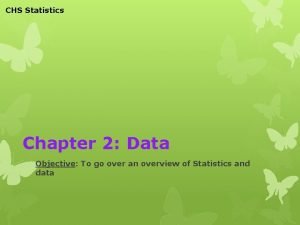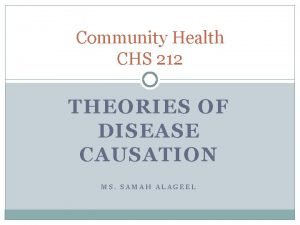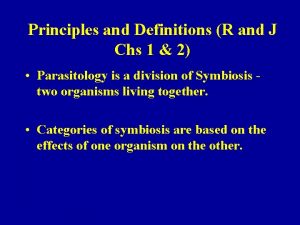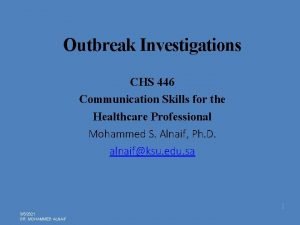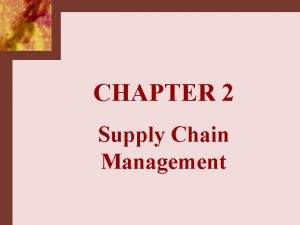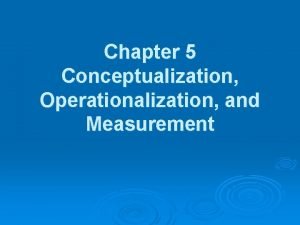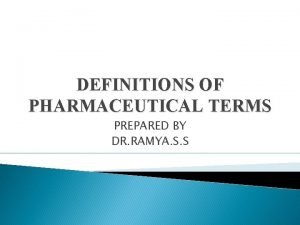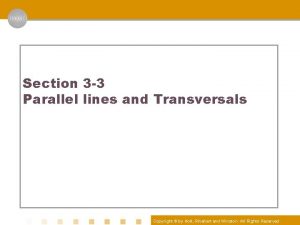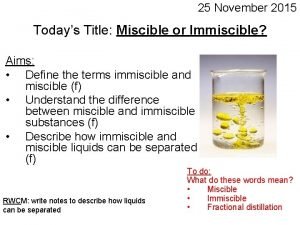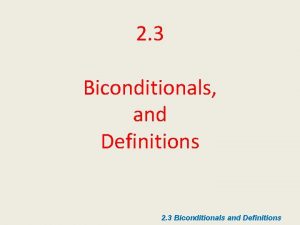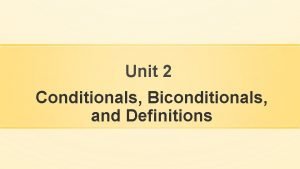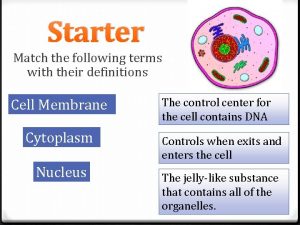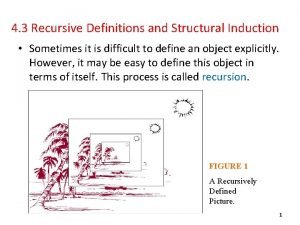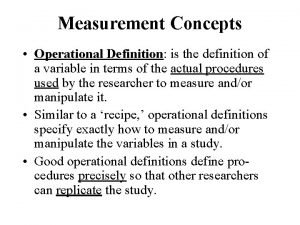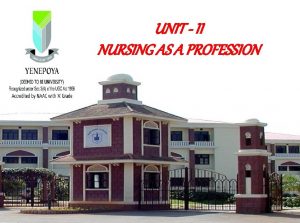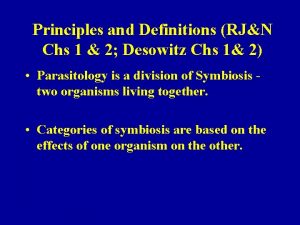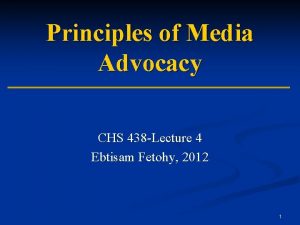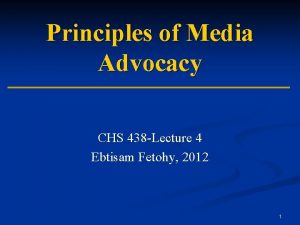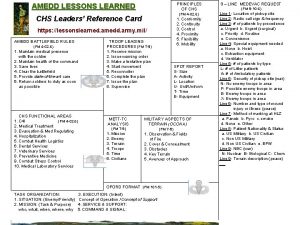Principles and Definitions R and J Chs 1





















































- Slides: 53

Principles and Definitions (R and J Chs 1 & 2) • Parasitology is a division of Symbiosis - two organisms living together. • Categories of symbiosis are based on the effects of one organism on the other.


Phoresis-2 organisms traveling together


Mutualism- 2 organisms living together in which both benefit from the association; both are metabolically dependent on one another


Commensalism- Relationship in which the symbiont benefits from an association with a host which is passive to the relationship (not harmed or benefited)

Parasitism- definitions: • Original meaning from the Greek is a relationship in which "one eats at another's table or lives at another's expense. “ • R&J page 4 - "Parasitism is a relationship in which one of the participants, the parasite, either harms its host or in some sense lives at the expense of the host. “

Entamoeba invadens

Entamoeba invadens

Parasitism- definitions: • Noble and Noble – Parasitology: The Biology of Animal Parasites "Parasitism is an obligatory association between two distinct species in which the dependence of the parasite upon its host is a metabolic one involving mutual exchange of substances. "

Our Definition Parasite-an organism which lives at least part of its life cycle on or within another organism (the host) upon which it is physiologically dependent and to which it causes harm in some way. In a parasitological or medical context, it is restricted to animal agents, i. e. , protozoa, helminths, and arthropods.

Where are Parasites Found?

A brooding Glossiphonid leech with its young feeding on my wife’s leg!

Where are Parasites Found? • Ectoparasite- a parasite which lives on the body surface of the host.


Where are Parasites Found? • Endoparasite- a parasite which lives within the body of the host.

Definitions of Hosts Many parasites have more than one host in their life cycle. These hosts have different roles and are given specific names.

Definitions of Hosts

Definitions of Hosts • Definitive host – a host in which the parasite reaches sexual maturity and undergoes reproduction.

Definitions of Hosts • Definitive host – a host in which the parasite reaches sexual maturity and undergoes reproduction. • Intermediate – a host in which the parasite undergoes larval development but does not reach sexual maturity.

Definitions of Hosts • Definitive host – a host in which the parasite reaches sexual maturity and undergoes reproduction. • Intermediate – a host in which the parasite undergoes larval development but does not reach sexual maturity. • Paratenic host (Transport host) – a host in which a parasite survives without undergoing further development. A paratenic host accumulates and maintains stages of a parasite, and although beneficial, is not essential to the life cycle.

Definitions of Hosts • Vector- any agent, either animate or inanimate (such as wind, water, or arthropod) that transmits an infectious organism.

Definitions of Hosts • Vector- any agent, either animate or inanimate (such as wind, water, or arthropod) that transmits an infectious organism. • Biological Vector- a vector in which a parasite lives or develops. The parasite undergoes morphologic change and/or multiplication, and the vector is usually essential for the life cycle.

Definitions of Hosts • Vector- any agent, either animate or inanimate (such as wind, water, or arthropod) that transmits an infectious organism. • Biological Vector- a vector in which a parasite lives or develops. The parasite undergoes morphologic change and/or multiplication, and the vector is usually essential for the life cycle. • Mechanical Vector- a vector which transmits a parasite by mechanical means only. It may be living or non-living and is not essential for the parasite’s life cycle.

Host-Parasite Relationships • Like other living organisms, parasites have basic need in order to survive and be successful.

Host-Parasite Relationships • • Habitat or substrate Energy source (food) Reproduction of own kind Dispersal

Host-Parasite Relationships • Living animals present special problems as habitats or environments.

Host-Parasite Relationships • They move around and disperse • They have non-specific defense mechanisms • They mount specific immune responses • They age and change physiologically • They die

Host-Parasite Relationships • Some of the most important factors influencing parasite transmission and infection are related to host behavior.

Echinococcus Tapeworms

Echinococcus species

Echinococcus multilocularis

Echinococcus granulosus Surgical removal of 3 unilocular hydatid cysts from a Kenyan woman.

Host-Parasite Relationships • • • Innate behaviors Learned behaviors Ethnic and cultural practices Local customs or habits Religious practices

Your Areas of Responsibility • Lectures • Any specific assignments given • A set of facts/info about selected species of parasites (A-I)

9 topics • A- Morphology (structure)-size

9 topics • B- Taxonomy: Largely based on morphology. Know where to place organism in the scheme of things. Phylum ? ? ? (Sarcodina)

9 topics • C – Life cycle, including the ontogenetic (developmental) stages and their size.

9 topics • C – Life cycle, including where found environmentally.


Be more specific! Habitat

9 topics • C – Life cycle, including prepatent period: The period of time from infection of a host with a parasite until one can demonstrate that the host is infected by finding a stage of the parasite (cyst, egg, larva, etc. ) in or from the host.

9 topics • D – Geographic distribution: Where in the world would you find it?


Trypanosoma gambiense



9 topics • E – Symptoms: Aspects which you observe (headaches, fever, jaundice, etc. )

9 topics • F – Pathology: Damage from infection. Physical damage/changes done to body which you can see. Otherwise know as the consequences of the infection.

9 topics • G – Diagnosis: How to look for the parasite, where to look, and what do you expect to see. Do not base on symptoms.

9 topics • H – Epidemiology: How does it spread thru a population?

9 topics • I – Drug of Choice and Prognosis: Treatment and what you expect to happen/prospects.
 Chs lancers
Chs lancers Creative house scaffolding
Creative house scaffolding Chs or ibs
Chs or ibs Chs statistics
Chs statistics St roberts catholic high school
St roberts catholic high school Example of chs theories
Example of chs theories Chs module
Chs module Parasitism
Parasitism Chs investigations
Chs investigations Chs.edf.school
Chs.edf.school Middle school classes
Middle school classes Budowa logiczna dysku twardego
Budowa logiczna dysku twardego Chs investigations
Chs investigations 3 types of irony
3 types of irony The problem of concept drift: definitions and related work
The problem of concept drift: definitions and related work The correct shutoff procedure for an oxyacetylene torch is:
The correct shutoff procedure for an oxyacetylene torch is: How to measure for birdsmouth cut
How to measure for birdsmouth cut Material properties definitions
Material properties definitions Vocabulary words for hatchet
Vocabulary words for hatchet News values
News values Compare and contrast defintion
Compare and contrast defintion Cscmp supply chain management definitions and glossary
Cscmp supply chain management definitions and glossary Undefined terms definition
Undefined terms definition What is the classification of kolitong
What is the classification of kolitong Film genres and definitions
Film genres and definitions Conceptualization operationalization and measurement
Conceptualization operationalization and measurement Biconditional geometry example
Biconditional geometry example Vertical
Vertical Match the verbs and prepositions
Match the verbs and prepositions Examples of reciprocal determinism
Examples of reciprocal determinism Restaurant terms and definitions
Restaurant terms and definitions Undefined terms and basic definitions worksheet answers
Undefined terms and basic definitions worksheet answers Pharmacopollaxy
Pharmacopollaxy Chapter 28 monomer liquid and polymer powder
Chapter 28 monomer liquid and polymer powder Biconditional statement
Biconditional statement Definition of same side interior angles
Definition of same side interior angles Miscible and immiscible definitions
Miscible and immiscible definitions Unit 3 lesson 2 biconditionals and definitions
Unit 3 lesson 2 biconditionals and definitions 2-2 statements conditionals and biconditionals
2-2 statements conditionals and biconditionals Match the following
Match the following Material properties definitions
Material properties definitions Indian dramas
Indian dramas Recursive definitions and structural induction
Recursive definitions and structural induction Science whmis symbols
Science whmis symbols What is operational definition
What is operational definition Poetic device example
Poetic device example The parts of a circle
The parts of a circle Nursing definition
Nursing definition Ankle rom
Ankle rom The meaning of public speaking
The meaning of public speaking Educational psychology meaning
Educational psychology meaning Project overall status
Project overall status Poverty definitions
Poverty definitions What is meaning
What is meaning



